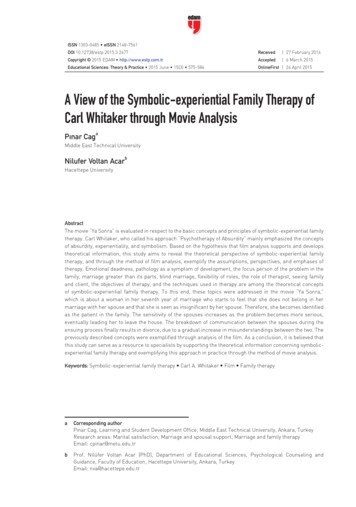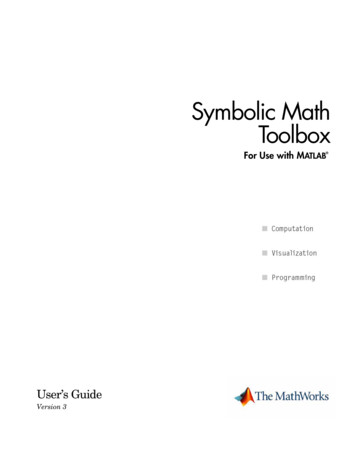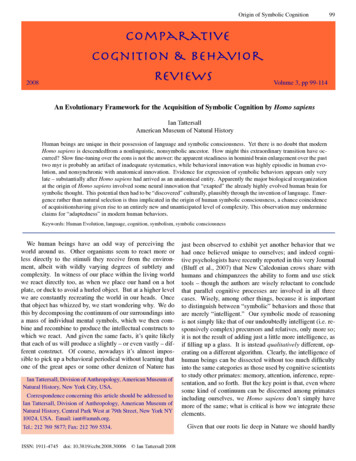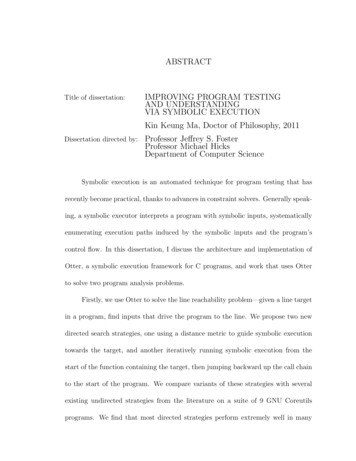
Transcription
ISSN 1303-0485 eISSN 2148-7561DOI 10.12738/estp.2015.3.2477Received 27 February 2014Copyright 2015 EDAM http://www.estp.com.trAccepted 6 March 2015Educational Sciences: Theory & Practice 2015 June 15(3) 575-586OnlineFirst 24 April 2015A View of the Symbolic-experiential Family Therapy ofCarl Whitaker through Movie AnalysisaPınar CagMiddle East Technical UniversitybNilufer Voltan AcarHacettepe UniversityAbstractThe movie “Ya Sonra” is evaluated in respect to the basic concepts and principles of symbolic-experiential familytherapy. Carl Whitaker, who called his approach “Psychotherapy of Absurdity” mainly emphasized the conceptsof absurdity, experientiality, and symbolism. Based on the hypothesis that film analysis supports and developstheoretical information, this study aims to reveal the theoretical perspective of symbolic-experiential familytherapy, and through the method of film analysis, exemplify the assumptions, perspectives, and emphases oftherapy. Emotional deadness, pathology as a symptom of development, the focus person of the problem in thefamily, marriage greater than its parts, blind marriage, flexibility of roles, the role of therapist, seeing familyand client, the objectives of therapy, and the techniques used in therapy are among the theoretical conceptsof symbolic-experiential family therapy. To this end, these topics were addressed in the movie “Ya Sonra,”which is about a woman in her seventh year of marriage who starts to feel that she does not belong in hermarriage with her spouse and that she is seen as insignificant by her spouse. Therefore, she becomes identifiedas the patient in the family. The sensitivity of the spouses increases as the problem becomes more serious,eventually leading her to leave the house. The breakdown of communication between the spouses during theensuing process finally results in divorce, due to a gradual increase in misunderstandings between the two. Thepreviously described concepts were exemplified through analysis of the film. As a conclusion, it is believed thatthis study can serve as a resource to specialists by supporting the theoretical information concerning symbolicexperiential family therapy and exemplifying this approach in practice through the method of movie analysis.Keywords: Symbolic-experiential family therapy Carl A. Whitaker Film Family therapyaCorresponding authorPınar Cag, Learning and Student Development Office, Middle East Technical University, Ankara, TurkeyResearch areas: Marital satisfaction; Marriage and spousal support; Marriage and family therapyEmail: cpinar@metu.edu.trbProf. Nilüfer Voltan Acar (PhD), Department of Educational Sciences, Psychological Counseling andGuidance, Faculty of Education, Hacettepe University, Ankara, TurkeyEmail: nva@hacettepe.edu.tr
Educational Sciences: Theory & PracticeThe background of family therapy resemblesan exciting novel. Several models of familytherapy abundantly suggest creative ideas andnew techniques. The leaders in creativity, such asMinuchin, Ackerman, Whitaker, Haley, and Satirare quite distinct in this field (Carson, 1999). It canbe suggested that experiential theories are moreprominent in terms of creative ideas. Although itis called non-theoretical experiential therapy, thisapproach facilitates creative experiences in families.Creative, spontaneous, non-rational experience is asignificant objective of experiential family therapy(Piercy, Sprenkle, Wetchler, & Associates, 1996 ascited in Carson, 1999). According to experientialtherapists, “This therapy depends on the interactiveprocess of intellectual understanding, metaphoriclanguage, and personal interaction” (Keith, 1982,p. 331 as cited in Bermudez, 1997). The mainobjective here is growth (Neill & Kniskern, 1982;Mitten & Piercy, 1993; Whitaker & Bumberry, 1988as cited in Bermudez, 1997).Experiential family therapy evolved in the decadesfollowing the humanistic psychology movement. Atfirst, founders of the approach were very interestedin the structures of treatment based on experience.Certain theorists of experiential family counselingsuch as Carl Whitaker relied more on their owncharacters, creativity, and spontaneity in respect totimely and effective responses in their studies withfamilies. The most significant roles adopted by thesetherapists include the roles of process facilitatorand source person (Gladding, 2012). Whitakerappreciates and adopts the absurd aspects of life.One of the experiential theorists who defends thesuggestion “One can only learn through experience”is Carl Whitaker (Whitaker & Bumberry, 1988,p. 73 as cited in Bermudez, 1997). Whitaker wasborn on a farm in New York in 1912, grew up asa very shy child with only his family in his socialcircle. Whitaker started to lay the foundationsof symbolic-experiential family therapy and itstheoretical structure (Martin, 2011). According toWhitaker and Keith (1981), a right-brain oriented,non-rational experience is an indicator of healthin the family for the therapist. Furthermore, a partof family problems stems from a lack of creativeproblem-solving skills in the family (as cited inCarson, 1999). His hypotheses and insecure theory,which was suspect to many, caused people to refrainfrom using this approach from time to time.People have certain needs and strong urges tounderstand and regulate their environment. Theoriesassist therapists with controlling and regulating the576environments of people. Whitaker went beyond theknown definition of “theory” by theorizing eventhe unknown of unknown (Smith, 1998) Therefore,he suggested an unusual theory defining differentconcepts which he did not establish on any expectedstructure. Whitaker used the concept of absurdityseveral times in his theory. The basic hypothesisof this theory is to ensure that family membersestablish a relationship with their own absurditieswithout restriction through emotional means.While working with families, Whitaker teased themthrough free behavioral and emotional means toprovoke them, and he supported the families incommunicating with their own absurdities. Whitakerput absurdity forward in studies on the subconsciousand emphasized the importance of spontaneityduring therapy. Such absurdity and unexpectednessprovide significant benefits in achieving the goalsof therapy. This is used to divide the problematicsituations of communication, change the interactionand perception of the therapeutic process, supportand open the reasoned “observer” role of the righthemisphere of the brain, and overcome therapeuticdeadlock and blockage (Watzlawick, 1974 as cited inCullin, 2008).As a family therapist, Whitaker was quite intuitiveand natural; he was not a constructivist. At this point,unlike many therapists, it is impossible to separateWhitaker’s approach from his personality (Gladding,2007). Therefore, he rejected giving instructions tomake a change in families. Instead, he carried out anon-theoretical and spontaneous therapy process inwhich he utterly used his own personality. Whitakerassumed that what motivates change in families isexperience rather than education. Another conceptemphasized by Whitaker is symbolism. One of themain functions of the brain cortex is obstruction.According to Whitaker, several of the experiencesa person has continue in the subconscious with thisobstruction, and the best method to reach theseexperiences is to be symbolic. What Whitaker meantby symbolic is that a thing or process embodiesmultiple meanings (Gladding, 2007). Whitakershared his “crazy” thoughts with families at thesame time he studied them so that he could supportthem in realizing that their lives were not as badas assumed and they could be stronger against theproblems of life. As he shared his thoughts, he oftenshared from his authentic identity and personalityso as to lead families to take their cue from him andbecome free (Dhanesar, 2006). Whitaker’s approachhas a structure which is difficult to learn due tospecificity to his own personality, its non-theoreticalstructure, and the emphasis on characteristics such
Cag, Voltan Acar / A View of the Symbolic-experiential Family Therapy of Carl Whitaker through Movie Analysisas intuitivism, creativity, and symbolism. This iswhy the direction which the therapy was headedbecame blurred and started to lose its popularityafter Whitaker’s demise. Currently, defenders ofthe therapy have gone on to develop this therapywithin post-modernism. Symbolic-experientialfamily therapy remained in the theoretical stagedue to the scarcity of literature concerning it as wellas the rapid changeability of its structure based onthe personality traits of the therapist. It could notbe further grounded as clear research could not beconducted on the practice and effectiveness of thetherapy.The purpose of experiential therapy is toprovide experience to clients and then create anenvironment to reflect this experience in their life(Banker, 2008). Therefore, experiential therapiesare difficult to apply and operate. As comparedto behavioral therapies, it is more difficult toresearch the effectiveness of experiential methods.Consequently, there are a limited number ofresearch studies in general on the outcomes andprocesses of experiential approaches (Mitten& Connell, 2004). Based on these grounds, it isassumed that a study on experiential therapiesusing a qualitative method known as filmanalysis, while providing difficulty for empiricalresearch, can shed light on the field. Therefore,as well as reviewing the theoretical structure ofsymbolic-experiential family therapy, reinforcingits theoretical importance by the method of filmanalysis also holds importance.In a general sense, the basic building block of allfilms is the human being. Therefore, each moviepresents personality traits of humanity while alsoconstituting an information source concerningthe concealed spiritual worlds of individuals(Horzum, 2011). Both films and novels can beused for educative purposes so as to develop newperspectives and ideas towards a particular situationor incident (Dermer & Hutchings, 2000). Severalsubjects such as culture, class, gender, power, andsexual orientation can be discovered through films;the variability in movies and its variety of characterscan offer the opportunity to discover a perspectiveof the world in a general sense even in just a briefscene (Dermer & Hutchings, 2000).One of several reasons for using films in therapy isthe fact that they can offer variety and variabilityfrom several perspectives (Dermer & Hutchings,2000). Therefore, it is not a new practice to use filmsin psychological counselor education (Gladstein &Feldstein, 1983 as cited in Villalba & Redmond,2008). Upon literature review of various professionaleducation orientations on psychological counseling,films are seen to have been used in various fieldssuch as ethics, psychopathology and diagnostics,group study, sensitivity to individual differences,and skills acquisition (Chambliss & Magakis, 1996;Koch & Dollarhide, 2000; Pinterits & Atkinson,1998 as cited in Villalba & Redmond, 2008).In selecting an appropriate film for film analysisstudies, the ability to establish the film on therapeutictheoretical ground is important. Therefore, selectinga film which includes certain family patterns and theunfolding of these patterns (Wilson, Blake, Taylor, &Hannigs, 2013) was taken into consideration as in theprevious studies. To this end, the film “Ya Sonra” wasselected with the opinion that it contains patternsconvenient for adapting Whitaker’s symbolicexperiential family therapy. The scenes from the filmwhich were estimated to set an example of Whitaker’sapproach were selected by researchers, and a generalevaluation was made for these scenes. To this end, thescenes which can be addressed from the perspectiveof the Whitaker approach were explained basedon the congruence with theoretical infrastructure.Starting from this point of view, basic explanationswere first made regarding theoretical informationand then a general evaluation of the married couplein the film was made using the Whitaker familytherapy approach. The scenes which were consistentwith the theoretical information were addressed andinterpreted. In summary, the method constitutedgathering the examples concerning Whitaker’ssymbolic experiential family therapy, an evaluationof the family in general, and then an analysis of theexplained scenes.Symbolic-Experiential Family TherapySymbolic-experiential family therapy is a nontheoretical and pragmatic approach whichunlike several other therapies is not structured.It is important for the therapist to use their ownpersonality, spontaneity, and creativity in symbolicexperiential family therapy. This approach focuseson emotions, and by establishing an efficient bondwith the family, it holds importance for revealingemotions. Its symbolism, non-verbal methods,employment of games, and use of an assistanttherapist are aspects which differentiate symbolicexperiential family therapy (Goldenberg &Goldenberg, 2008). Marriage and family therapiesemploy more creative techniques and methodssimilar to symbolic experiential family therapy, andthe therapist interacts directly with family members.577
Educational Sciences: Theory & PracticeWithin this process, the therapist participates usingtheir own personality as well as their self-reflectionand involvement. This has critical importancein gathering family members and having a moreentertaining time; the interactive style of thetherapist also demonstrates the importance of firsthand interaction to family members (Thompson,Bender, Cardoso, & Flynn, 2011).While explaining his theory and teaching hisstudents, Whitaker stated that being themselvesat all times, feeding from their own creativity andsurrendering themselves to the process as it is withall of their absurdities and naturalness is sufficient forstudying with families (Sugarman, 1987). Whitakerwent beyond the known definition of theory andtheorized even the unknown of unknown. Becauseof this, he suggested an uncommon theory, defineda different structure, and established his theory onan expected structure. Whitaker used the concept ofabsurdity several times in his theory. While studyingwith families, Whitaker provoked them with freebehavioral and emotional methods in order tosupport them with communication using theirown absurdity. Such absurdity and unexpectednessproved a major benefit for the achievement of thegoals of therapy. As a family therapist, Whitaker isquite intuitive and natural; he is not a structuralist.Therefore, he rejected giving instructions to ensurechange in families and he carried out a nontheoretical, spontaneous therapeutic process in whichhe utterly used his own personality (Smith, 1998).Whitaker stated that he was influenced by psychodynamic theory based on the opinion that there arecertain processes lying in the human subconsciousand these can only be revealed symbolically.Whitaker also emphasized the concept of awarenessin his therapy and mentioned that awareness hasan ego-developing trait as well as the existence of atransference component. According to Whitaker,people refer their emotional attributions from thepast onto their current spouses. In addition to this,symbolic-experiential family therapy researchesthe symptoms of the family in wider generations ofthe family, 2 to 3 generations retrospectively, anddefends the hypothesis that their past experiencesaffect their current family patterns. This therapy alsoaims at receiving information from the dreams andfantasies of families with the assumption that thesecan help reach symbolic parts and signs. The factthat Whitaker considers experience important ratherthan education indicates that his therapy is basedon phenomenological, experiential, and existentialorigins. Whitaker also places importance to the “hereand now” which is among the basic principles of578existential and humanistic approach. He focuses onthe current experience and what is happening in thismoment rather than the past or future. Accordingto Whitaker, marriage is greater than its parts(Whitaker, Greenberg & Greenberg, 1979 as cited inMartin, 2011). Based on this point of view, it can bepossible to state that Whitaker took inspiration fromGestalt therapy through the opinion that the whole ismore than the sum of its parts.The educative aspect of Whitaker’s therapy has acontinuous basis. He had technical observationsand ideas about the nature of psychotherapy; hehad a lively, active, and interested approach inhis family counseling studies for both individualsand married couples. His orientation within thecounseling process was based on his subjectiveexperiences and the creativity of his experiences.He did not depend on any systematic doctrine orwritten rules of any formal system. In this aspect,it is possible to say that the majority of traits whichdistinguish Whitaker from other clinicians andmade him capable is based on his creative worldand self-identity (Neill & Kniskern, 1989). It isdifficult to put this structure, which is unique toWhitaker, into practice. According to Whitaker,symbolic-experiential family therapy cannotpossibly be learned in a direct intellectual context.It can only be learned through experience (Mitten,1996). It has been mentioned in the literaturethat Whitaker’s approach has components whichstrongly comply with the postmodern structure(Smith, 1998). Family therapy has started toincreasingly be influenced by postmodernism andstructuralism. System theory serves as a bridgein the transmission to postmodern thought.Family therapy was developed by psychiatristswho were not happy and could not be satisfiedwith individual therapy. They progressed with thepostmodern thought of system theory in familytherapy (Braderick & Schrader, 1991 as cited inSmith, 1998). When Whitaker realized he wouldnot be satisfied with individual therapy process,he started to study with families. When he startedto study with families, he accepted the importanceof systematic thought in family interactions to ahigher degree. Upon reviewing the postmodernistperspectives of Whitaker, the first ones that canbe seen are symbolism, experientialism, and thesubjective nature of experiences, all of which arein good harmony with the personal and subjectivefacts of postmodernism. Secondly, the nontheoretical structure of Whitaker’s approach, hislack of confidence in theories, and the fact that hefound subjective fact more important also complies
Cag, Voltan Acar / A View of the Symbolic-experiential Family Therapy of Carl Whitaker through Movie Analysiswith subjectivity, which is the basic building blockof postmodernism. Thirdly, it is assumed that theuse of intuitivism in Whitaker’s therapy is basicallythe charm of postmodernism, and intuitivismadds a post-modernistic flavor which is rightbrain oriented, personal, and subjective by nature.Fourthly, the overemphasis made by Whitakeron the therapist themselves in their approachis strongly in compliance with the recreationalcomponent of postmodern thought. In addition toall of these, the majority of therapeutic techniquesadopted by Whitaker such as war for initiative,withdrawal, language of options, co-therapist,consultation, and termination are in good harmonywith the postmodern paradigm (Smith, 1998). The main focus of this therapy is not toextinguish family symbols but to rearrange andreform these symbols (Mitten, 1996). Startingfrom this point of view, it is assumed that theexperiences, emotions, and feelings of theindividual are assumed to be the strength oftheir symbolic worlds. It can be mentioned thatthese experiences provide clients and therapistwith an opportunity for self-improvement. Thebasic principles of this approach are as follows(Kempler, 1981 as cited in Martin, 2011):Thesymbolic scope of family requires study. In therapy sessions, the nature of new experiencesshould be tried. The therapist has to ensure completeparticipation and sharing in order to achieve thegoals in a group.In this therapy, the unique family symbolswhich are hidden beneath personal and familialdevelopment are focused on (Connell et al.,1999 as cited in Martin, 2011). Therefore, aninexperienced therapist should know that themeanings behind these symbols may change asthe therapy progresses, and they should study bylearning certain principles. Therapy makes severalassumptions on the formation of human potential,marriage, life, and growth-development. Some ofthese are given below: Every individual and family has the capacityto develop, yet they may not have hope inmaintaining it. Every individual is capable of selecting how tochoose their life, yet the majority of these choicesare based on their experiences with their families. All individuals have the potential to grow anddevelop. Whitaker believed “humans are merelyparticles of families” (Connell et al., 1999 as citedin Martin, 2011). People develop their values,beliefs, cultural identities, and sensitivities intheir relationships and they can reform andchange them. This leads to the hypothesis thatpeople are similar rather than different andeveryone seeks development. For family members, the protection, guarding,and maintenance of their own sensitivity, oridentity of self, while at the same time belongingto the family is important. This model considersthe influence of the family on themselves, and itnaturally supports the development and growth ofthe individual by helping them protect themselves.At this stage, the therapist encourages the personalgrowth of the individual to help maintain it, andensures that the family perceives the developmentof this person as the development and growth ofthe family at the same time.Evaluation of Film “Ya Sonra” in Respect toSymbolic-Experiential Family TherapyThe use of films as a therapeutic instrument has beenput on the agenda in the literature in recent years.Various researches, in which movies are used as botha method of intervention in psychotherapy and aninstrument in the education of psychotherapists,are found in the world literature. Movies are statedto be strong therapeutic metaphors and they consistof components which strengthen the relationshipbetween therapist and client, intensify the emotionsof clients, and increase the awareness concerningtheir internal difficulties. Films help individuals solvetheir problems by allowing the individual to gain anoutsider perspective to their problem, generatingalternative perspectives to problems for whichthey could not previously find a solution, givingmeaning to their problems, and developing new andfunctional skills for overcoming issues (Alexander& Waxman, 2000; Hesley & Hesley, 2001 as cited inDurak & Fışıoğlu, 2007; Dermer & Hutchings, 2000).Films can be used as positive educationalinstruments (Wedding & Niemiec, 2003). Theemployment of films in education, generallyor specifically, in family counseling educationhas been developed. It can be seen that studiesconducted through movies in the area of familycounseling in particular prove beneficial to studentswith conceptualization and with understanding theconcept of the family system. It also provides bothstudents and educators with different perspectivesconcerning theoretical information (Nadir, 2013).579
Educational Sciences: Theory & PracticeAnother advantage of using films in educationis the opportunity to probe, understand, andobserve non-verbal behaviors in addition toverbal behaviors (Shepard & Brew, 2005 as cited inNadir, 2013), which is important for discoveringnon-verbal messages in educational fields such aspsychological counseling and psychology.Movies can be used therapeutically to createprofessional objectives in the area of psychologicalcounseling and guidance as well. Popular mediaand films can be used for educative purposes aswell as for acquiring professional goals. While Kelly(1998) used silent film scenes to teach complicatedsyntax to deaf adults, Watson and Van Etten (1997)used films to change and understand attitudesabout childhood obstacles. Nugent and Shaunessy(2003) used films in on-the-job training deliveredto teachers for understanding the needs andcharacteristics of child prodigies. Madan-Bahel(2005) referred to films for teaching importantpoints and creating a discussion for a sexual healthprogram, while Stincfield (2006) used films toteach systematic thinking (cited in Powell, 2008).Similarly, it is aimed in this study to give bettermeaning to the infrastructure of the theory andshed light on students, professionals in the field,and educators as well.This part of the study was exemplified usingimplementation of symbolic-experiential familytherapy implementation through the movieanalysis method. Exemplification of the conceptsof Whitaker’s symbolic-experiential family therapy,which have been explained in this article, wasattempted through analysis of the film “Ya Sonra”so as to support the theoretical information.Plot: General information about the film1:Film: “Ya Sonra”Production: 2010-TurkeyGenre: Drama, Comedy, RomanticRunning Time: 105 minutesDirector: Özcan DenizCast: Ayşen Gruda, Deniz Çakır, Cezmi Baskın,Naz Elmas, Barış Falay, Özcan Deniz, Didem Erol,Janset Paçal, Ragıp Savaş, Fatma Toptaş, ErdemAkakçe, Mehmet Ulay, Aliye Uzunatağan, BülentSeyran, Mehmet Aslan, Atakan Ilgazdağ, AltuğYücel, İsmail DüvenciScenario: Özcan Deniz1Cited from the introduction of the film on itswebsite.580Producer: Ercan Deniz, Sinan Tekin, Vural TurunçPlot: Didem and Adem had a great love. They flirtedfor 11 years before their marriage, and have beenmarried for 7 years. Didem is an architect in acompany. Adem is a veterinary in his own clinic.By the seventh year of their marriage, which startedwith a deep love, they find there is a communicationgap increasing with the residual effects of the past.As a person who is more connected to the socialworld than his own home, Adem plays a characterwho becomes increasingly more selfish and hasdifficulty giving the attention and love his spouselongs for. Adem has exceedingly started to live forhimself and become selfish whereas Didem hasstarted to question her marriage by mentioningher discontent with the situation. Adem could notexactly give a response to Didem who was trying totalk about their problems and seek solutions. Thisled to deteriorating issues and eventually, divorce.In this study, examples concerning concepts insymbolic-experiential family therapy were gatheredand the family was first generally evaluated.Afterwards, the scenes concerning therapy wereexplained and analyzed.Evaluation of Film through SymbolicExperiential Family Therapy and Analysis ofScenesUpon evaluation of the film, examples concerningemotional deadness, pathology as a symptom ofdevelopment, the focus person of the problemin the family, a marriage greater than its parts,blind marriage, and flexibility of roles, which areincluded in Whitaker’s approach, were seen invarious scenes. The analysis of the film is presentedwith Whitaker’s approach in the framework ofscenes concerning each one of these aspects. In thistherapy, the majority of which is postmodernist,certain concepts are addressed for use in the filmanalysis. These are emotional deadness, pathologyas a symptom of development, focus person of theproblem in the family (identified patient, or IP),marriage greater than its parts, blind marriage, andflexibility of roles.Emotional Deadness: Whitaker’s approach is basedon the hypothesis that individuals are not awareof their emotions, or that they are aware of theiremotions but suppress them within the family.As individuals who behave like this within thefamily do not realize or reveal their new emotions,emotional deadness occurs in the family. Thisshows its symptoms on the family members. When
Cag, Voltan Acar / A View of the Symbolic-experiential Family Therapy of Carl Whitaker through Movie Analysisemotional deadness has occurred in the family, eachindividual grows distant from each other and engagein things outside the family. Such behaviors decreasethe functionality of the family. Therefore, familymembers are motivated to interact with each otherand expressly state their emotions (Gladding, 2007).At the beginning of the film, Adem and Didem sitat a bar with an all-male group of Adem’s friends .The subject of marriage is brought up and Ademsays to his 40-year old bachelor-friend who wants toget married, “Why would you get married, are youinsane? Do you want to get married to make yourlife fall apart?” In response to this reaction, Didemis petrified. Thereafter, she keeps her distance fromAdem. While they are in the car going back home,Adem apologizes, yet Didem’s resentment doesnot lessen. Adem cannot understand why Didemcontinues to keep her distance even though hehas apologized, and without regard to his spouse’sresentment, says, “Come on love, I don’t want tohave a quarrel with you. I am going to be sick, makeme that nice soup of yours,” and avoids the subject.Didem’s resentment flares up even more sinceno attention was paid to it. At this stage, Didemsuppresses her emotions to prevent the situationfrom getting worse and continues with her marriage.For the second example, Adem comes home withhis friends to watch a football game unannouncedwhile Didem, who has a very important presentationat work the next day, is working on her drawing athome. Didem pulls Adem over to the side and tellshim he doesn’t care about her or her job at all. Shegets angry with him for his thoughtless acts, yetAdem again avoids the situation by saying, “Youcan sit down and work, and we won’t disturb you.”Didem suffers another great disappointment andremains silent since she has no solution. She feelseven more hopeless as she cannot find a solution eventhough she mentioned her resentment with anger.She retreats. At this stage, the emotional deadnessthat slowly begins to form between the couple canactually be seen through the pattern of incident andincreasingly wider communi
ensuing process finally results in divorce, due to a gradual increase in misunderstandings between the two. The previously described concepts were exemplified through analysis of the film. As a conclusion, it is believed that this study can serve as a resource to specialists by supporting the theoretical information concerning symbolic-










